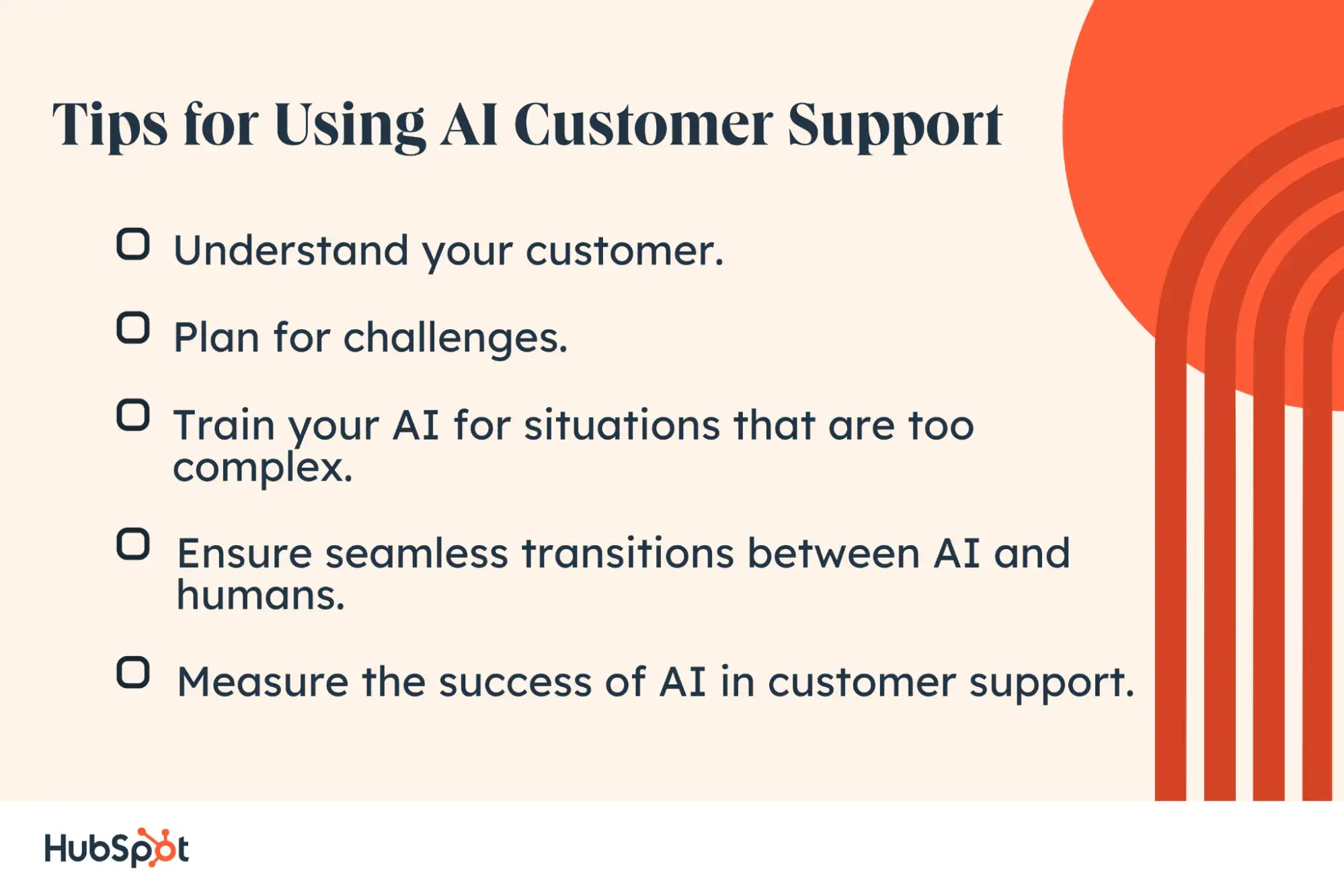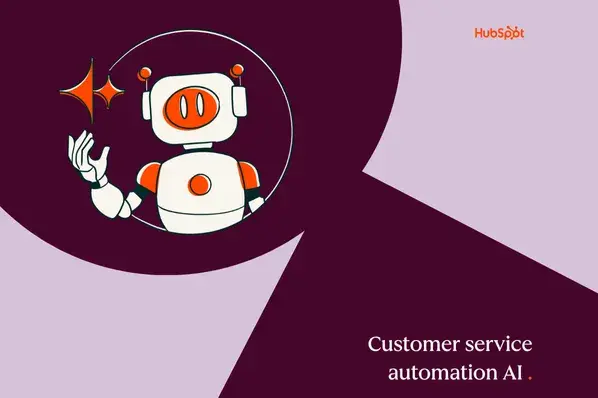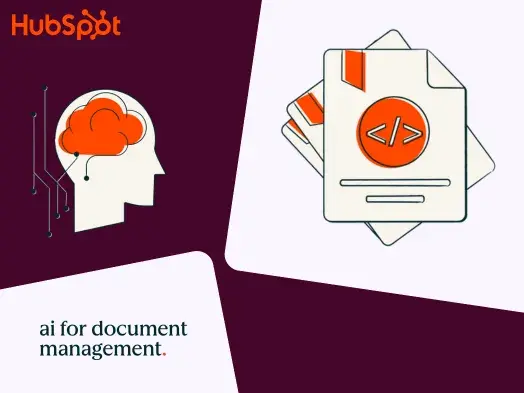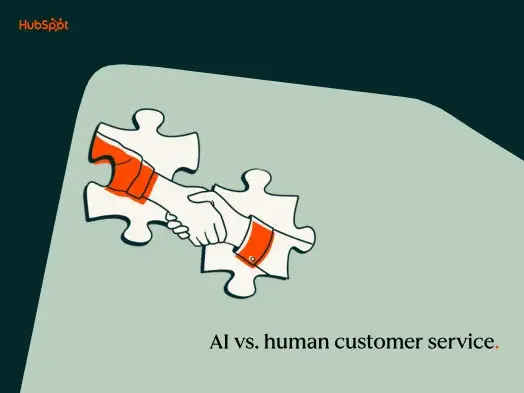In this post, we’ll define AI customer support, discuss its uses in customer support processes, and share tips from customer services experts on how to implement AI into your workflows.
Table of Contents
- What is AI Customer Support?
- Types of AI Customer Support
- How to Implement AI Customer Support
- Tips for Using AI Customer Support
What is AI Customer Support?
AI customer support uses artificial intelligence, such as natural language processing and machine learning, to automate certain support-related tasks, like responding to customer inquiries and scheduling appointments.
AI can vastly improve customer service response times, helping to improve the customer experience and create brand loyalty. In fact, 79% of customer service professionals say AI and automation improve their support strategy.
While some aspects of the customer support role require human-to-human interaction, AI-enabled software can provide better analytics so you and your team can improve your workflows and support services based on how your customers interact with and feel about your brand.
Types of AI Customer Support
AI can be integrated into nearly every aspect of customer support. Not sold yet? I’ll show you a few use cases of generative AI to improve customer service so you can learn what might be a good fit for you and your team.
Chatbots
Chatbots might just be one of the most popular applications of AI in customer service, and you’ve likely had personal experience with them. AI-powered chatbots are trained using company and industry data. This means when a customer interacts with the bot, the bot can anticipate and provide the best possible response to their query.

Mongoose, an engagement platform for higher education, uses a chatbot, Otto, to engage with customers and potential leads. Otto starts the conversation by asking if the visitor uses the platform and, depending on the answer, offers suggestions for new conversation topics.
I like to use chatbots like this to guide conversations, convert leads, or start initial support tickets.
Virtual Assistants
I think of virtual assistants as the cool cousins of a chatbot. Some AI-powered chatbots are limited in features, meaning they can only suggest new learning topics for users. AI virtual assistants step it up a notch and aid in customer support by providing customers assistance with things like scheduling appointments, placing orders, or providing tracking information.

Dom, Domino’s ordering assistant, is a perfect example of using a virtual assistant to help customers. Using Dom, pizza lovers can quickly order their favorite pie or easily browse the menu for new ordering ideas. I’m one of those people who eat with her eyes, so being able to see a cooked dish while using Dom also helps in my decision-making.
Voice Assistants
If you’re an iPhone user like me, you know all about the usefulness of Siri. Siri and Alexa are AI-powered voice assistants that every day users can use to complete certain tasks, like sending text messages or setting reminders. When it comes to customer support, businesses can use the same kind of technology to support callers, especially if all other phone lines are busy.

Voice assistants aid in customer service by helping customers do certain tasks like setting up service appointments, paying their bills, or checking the status of their orders. I use Xfinity as an internet service provider.
The few times I have had to call and report a problem, I’ve noticed Xfinity uses a voice assistant to greet their customers initially, and depending on their inquiry, it will connect them to a live agent who can further assist them.
Email Responders
If you’re part of a customer support team, you know your inbox is constantly flooded with customer support requests. It can take some time to sort through emails to find high-priority messages. Even though your team is on top of responding to all customer requests, some important tickets can fall through the cracks.
AI email responders help solve that issue. Email responders analyze customer communications, sort them based on priority, and can suggest replies to help you and your team automate responses.
Analytics for Customer Insight
Generative AI can improve customer service in many ways, but one of the best uses of this technology is uncovering customer insights. Adding AI to your CRM, like HubSpot AI, can help you understand your customers’ behaviors and how they interact with your brand. When you know how and why they interact with your brand, you’re better able to provide targeted support.

Plus, if your support agents understand customer sentiment before interacting and troubleshooting with a customer, they’re better able to tailor their delivery to ease tensions and maintain a positive customer-brand relationship.
Now that you know how AI can be used in customer support, let’s look at the best way to implement it.
Because there are various uses for AI in customer support, you need to make a plan and do a little research before implementing new software into your customer support processes. The wrong tool can cause a headache for your support team — or worse, cause issues for your clients.
To get a better idea of how to implement an AI tool into customer support, I talked with some customer service experts. Here’s what they suggest you do if you want to use generative AI to improve customer service.
Step 1: Define your goals.
Before I start anything new, whether that’s an exercise program or a business initiative, I find it helpful to define my goals. The same goes for using AI customer support tools. You need to define which of your customer support processes you can streamline with AI and which should be handled by a customer service rep.
Lasandra Barksdale, founder and principal of Kompass Customer Solutions, says to ask yourself this question: “Does this technology enhance our connection to our customers or increase the gap?”
Take some time to reflect on this question, brainstorm ideas, and ask for input from your team. Your team members can provide valuable insight into which of their job functions you can use AI to automate. From there, establish a timeline to implement new software.
Step 2: Gather and analyze customer support data.
Next, you’ll want to gather and analyze customer support data. You should look at things like:
- The volume of support tickets received
- Response times
- Satisfaction ratings
- Service logs
If you have the ability to conduct sentiment analysis, you should do that during this step, too. Be sure to also ask your team about any common customer pain points and complaints.
Step 3: Pick your AI tool.
By now, you should have a good idea of areas of improvement within your customer service processes. Take some time to research the various tools on the market that can help alleviate some of your customer service challenges.
For example if you need to work on faster response times, consider implementing an AI autoresponder tool for emails and support tickets. Or, if you’re losing visitors on your website, consider adding an AI chatbot to increase engagement.
Step 4: Train your tool.
Once you’ve chosen your AI tool and paid for a subscription to the service, you’ll need to spend some time training your bot. This means you’ll upload your company and customer data to the tool.
Barksdales also told me, “You have to feed your AI the right data. You have to train it with real customer interactions by feeding it diverse datasets that reflect the real questions and concerns our customers have, not just the ideal ones. To do this well, you have to make sure you have feedback loops set up to make sure learning is ongoing. This will keep your AI put to date on customer needs and ensure that it evolves as your customers do.”
To get the best, most accurate responses from your AI software, be sure to clean your data and remove any junk parameters before uploading it to the software. Bad data could lead to inappropriate responses. Take some time to train it using various tones and interaction styles — this way, you can be sure your AI tool can pick up on various sentiments.
Step 5: Test it.
After you’ve trained your tool using your company and customer data, it’s time to test it. Listen to me when I say this: you do not want to prematurely launch your AI tool. Launching your tool before your team fully understands how to best use it is a recipe for disaster.
Instead, assign members of your support team to be superusers. Give them early access to the tool and ask them to test it according to how they plan to use it in their everyday role.
Be sure to track appropriate performance metrics,too. Smitha Baliga, CEO and COO of TeleDirect Communications, told me that measuring effectiveness can vary by organization, but it's generally accepted as best practice to measure the following data points:
- Any customer feedback
- Resolution rate
- Customer satisfaction
- Average handling time
- Escalation rate”
Tracking these metrics while testing can ensure your AI tool supports your customer service efforts, not hinder them.
Step 6: Launch and ask customer feedback.
If your AI tool is customer-facing, you might need to announce the launch of your AI tool. This could be an email or a social media post to let your customers know they might see a new chatbot or a virtual assistant on your website. Be sure to set up a user experience survey, so you can gather customer feedback and opinions.
And, for good measure, if the tool is not customer-facing but is rep-facing, like an analytics tool or an autoresponder, you’ll want to ask your team for feedback, too.
Use the feedback from your customers and team members to make changes to continue to improve your workflows.
Tips for Using AI Customer Support
Adding AI to your support processes can be a game-changer for your customers and your support team. Depending on the tool, you can increase response rates, decrease negative interactions, and mitigate tense situations by gaining a deeper understanding of the customer and their concerns through analytical insights.
I asked a few customer support experts for their best tips on using AI in customer support. Here’s what they told me.

1. Understand your customer.
Understanding your customers and their needs is a top priority for your business, but especially for your customer support reps who are looking to implement an AI tool.
Bobby Hakimi, chief product officer and co-founder of Convoso, told me, “Review everyday customer needs, pain points, and expectations at each stage, and identify critical touchpoints where the AI will interact with customers. Train the model to recognize customer segments and tailor responses to those segments.”
2. Plan for challenges.
With the launch of any new software, there will be challenges to overcome. It’s inevitable.
Edward Tian, CEO of GTPZero, said the biggest challenge with using AI in customer support is that AI simply can’t handle every single inquiry.
“When you use it in place of real customer support agents, there will be times in which the technology can’t help the customer,” he explained. “That can then increase frustration on the customer’s end because now they’ve wasted time trying to use this tech service, when they could have just contacted a customer support agent directly. So, when AI for customer service works, it’s really great, but when it doesn’t work, the outcome is worse.”
3. Train your AI for situations that are too complex.
AI is good, but it can’t properly handle every customer inquiry or interaction. Some customers need specialized support, and you need to train your AI tool to recognize these situations.
Hakimi suggested, “Train the AI on when to escalate by recognizing when a query is too complex or sensitive and needs to be routed to a human agent. Build a path to a seamless transfer of the conversion, delivering the context and relevant information to the agent.”
4. Ensure seamless transitions between AI and humans.
Speaking of delivering content and information to a live agent, Barksdale had a tip for that, too. She said to ensure seamless transitions between AI and human agents you should consider the customer journey.
Barksdale said, “There‘s a big difference in needing to call a life insurance company because you can’t access the website versus after a family member has passed. Identify the moments that matter in each journey and make sure that high-emotion interactions are handled by a human. This requires well-defined triggers and a clear understanding of when AI should pass the baton to a human.”
5. Measure the success of AI in customer support.
Barksdale’s last tip is to measure the success of AI in customer support.
Barksdale told me, “You have to measure more than just response times, but also focus on CSAT scores and resolution rates of complex issues. Make sure to do A/B testing and pre- and post-implementation analysis to understand whether AI is directly impacting metrics or if other factors are influencing the results. At the end of the day, it’s about how well AI complements your customer support team.”
Maximize the Full Potential of Generative AI to Improve Customer Service
Generative AI in customer support is more than just adding a chatbot to your website to catch customer interactions. Sure, chatbots are a great use of generative AI, but there are other ways to use it to support your customer support initiatives — especially if you want to improve every aspect of your customer experience.
AI tools can help your team better understand your customers and their feelings, while also filtering out higher priority support tickets. That helps you can ensure you’re taking care of customer needs when they arise. Just be sure to follow the advice of our experts when implementing an AI tool, so you know it helps improve your processes, not make them worse.
Artificial Intelligence









![How AI Can Unlock Customer Insights [+Expert Tips]](https://53.fs1.hubspotusercontent-na1.net/hubfs/53/customer-insights-ai-1-20241101-2082956.webp)


